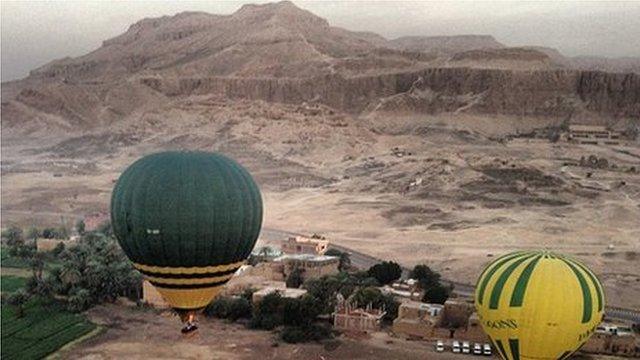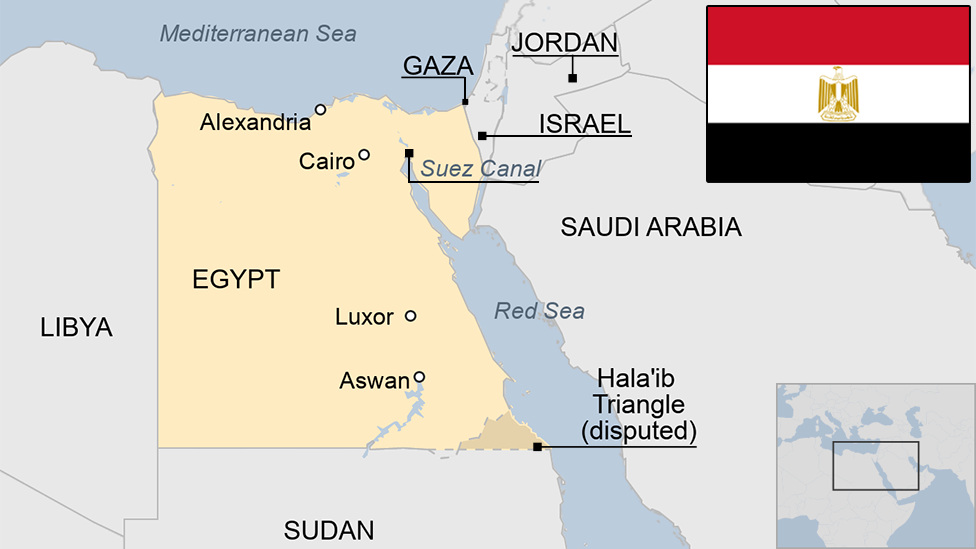Crash casts pall over Egypt tourism image
- Published

The crash follows two previous similar accidents
A hot air balloon crash which killed 19 people near Luxor has cast a further pall over Egypt's hard-hit tourism industry.
In the aftermath of the apparent accident, fears are being raised about the impact on one of the most popular activities among visitors drawn to the country's ancient sites, as the BBC's Yolande Knell reports.
A dawn flight in a hot air balloon over the River Nile taking in the ancient temples, monuments and tombs is supposed to be the highlight of a tourist's trip to Luxor.
But for a group of European and Asian holidaymakers the adventure with an operator called Sky Cruise ended in disaster.
An investigation into how the balloon caught fire and exploded in mid-air is now under way by Egypt's Civil Aviation Authority and general prosecutor. It is thought that a gas cylinder may have blown up.
The terrible accident looks set to deal another blow to the Egyptian tourism industry, which employs one in 10 workers and is one of the economy's main sources of foreign revenue.
It has already seen two years of political turmoil since the fall of President Hosni Mubarak.
"The industry has been slowly starting to recover this year. In 2012 there were 10.6m tourists, up from 8.9m in 2011 but still significantly down on the 13.5m we saw in 2010," says economist Moustafa Bassiouny of Cairo-based think-tank Signet Institute.
Media coverage showing continuing violence and unrest have put tourists off.
"There has been a failure to market Egypt as multiple destinations. Most problems have been in Cairo and the Suez Canal cities. South Sinai is safe for tourists and up to now there have been no major incidents in the South," Mr Bassiouny says.
Flights grounded
But this explosion will increase fears about Egypt's public safety standards. Already there is widespread anger in the country over recent fatal transport and construction accidents.
This is not the first time that a hot air balloon has crashed. There were a spate of crashes between 2006 and 2009 in which passengers were injured.
In April 2009, 16 people were hurt when their balloon struck a mobile phone mast.
After that accident, there was a temporary suspension of hot air balloon flights while safety measures were improved.
Pilots were given extra training, limits were placed on the number of passengers a balloon could carry and a new hot air balloon airport was opened.
The measures however did not prevent an even worse incident just three years later.
"We have never seen anything quite like this in Luxor before. It is an awful thing," the Luxor governor, Ezzat Saad, told me after visiting two survivors of the latest crash at local hospitals and surveying the sugar cane fields where bodies were being recovered.
"For the safety of the tourists and the Egyptians I have ordered all the companies dealing with balloons to stop flights until we know exactly what happened and the reasons for it," he said.
Tourism slump
Upper Egypt is one of the poorest regions of the country. Many locals are poorly educated and unskilled, working in agriculture.
It has been badly affected by the recent downturn in tourism. Luxor's hotels are currently about 25% full at what is supposed to be the peak of the winter season.
The main attractions in the city are the Karnak and Luxor temples as well as the Valley of the Kings on the West Bank of the Nile.
Officials say they hope that the latest accident will not have a further adverse effect on locals' livelihoods.
"We have been unlucky in Luxor and Aswan as the so-called cultural tourism has been down this year and last year also," Mr Saad says.
"This is an isolated incident, it is not a terrorist act or something like that. I hope it will be looked at in that context. We don't need more problems to stop tourists coming to Luxor."
- Published26 February 2013

- Published26 February 2013
- Published26 February 2013
- Published2 January 2024
